
The First Battle of Bull Run, also known as the Battle of First Manassas, was the first major battle of the American Civil War. The battle was fought on July 21, 1861, in Prince William County, Virginia, just north of the city of Manassas and about 30 miles west-southwest of Washington, D.C. The Union's forces were slow in positioning themselves, allowing Confederate reinforcements time to arrive by rail. Each side had about 18,000 poorly trained and poorly led troops. It was a Confederate victory, followed by a disorganized retreat of the Union forces.

The Battle of Philippi formed part of the Western Virginia Campaign of the American Civil War and was fought in and around Philippi, Virginia, on June 3, 1861. A Union victory, it was the first organized land action of the war, though generally viewed as a skirmish rather than a battle. However, the Northern press celebrated it as an epic triumph and this encouraged Congress to call for the drive on Richmond that ended with the Union defeat at First Bull Run in July. It brought overnight fame to Maj. Gen. George B. McClellan and was notable for the first battlefield amputations. As the first of a series of victories that pushed Confederate forces out of northwest Virginia, it strengthened the Union government in exile that would soon create the new state of West Virginia.
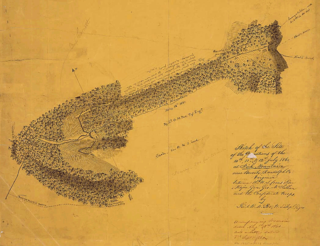
The Battle of Rich Mountain took place on July 11, 1861, in Randolph County, Virginia as part of the Operations in Western Virginia Campaign during the American Civil War.
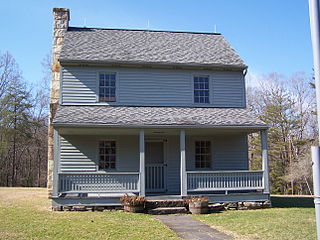
The Battle of Carnifex Ferry took place on September 10, 1861 in Nicholas County, Virginia, as part of the Operations in Western Virginia Campaign during the American Civil War. The battle resulted in a Union strategic victory that contributed to the eventual Confederate withdrawal from western Virginia, which in turn led to the creation of the State of West Virginia two years later.

The Battle of Cheat Mountain, also known as the Battle of Cheat Summit Fort, took place from September 12 to 15, 1861, in Pocahontas County and Randolph County, Virginia as part of the Western Virginia Campaign during the American Civil War. It was the first battle of the Civil War in which Robert E. Lee led troops into combat. During the battle, Lee attempted to surround the Union garrison atop Cheat Mountain, but the attack was never launched, due to false information from prisoners and poor communications among the various Confederate commands.

The Battle of Hoke's Run, also known as the Battle of Falling Waters or Battle of Hainesville, took place on July 2, 1861, in Berkeley County, Virginia as part of the Manassas campaign of the American Civil War. Notable as an early engagement of Confederate Colonel Thomas J. Jackson and his Brigade of Virginia Volunteers, nineteen days before their famous nickname would originate, this brief skirmish was hailed by both sides as a stern lesson to the other. Acting precisely upon the orders of a superior officer about how to operate in the face of superior numbers, Jackson's forces resisted General Robert Patterson's Union forces briefly and then slowly retreated over several miles.

The Battle of Front Royal, also known as Guard Hill or Cedarville, was fought May 23, 1862, in Warren County, Virginia, as part of Confederate Army Maj. Gen. Thomas J. "Stonewall" Jackson's Campaign through the Shenandoah Valley during the American Civil War. Front Royal demonstrated Jackson's use of Valley topography and mobility to unite his own forces while dividing those of his enemies. At a minimal cost, he forced the withdrawal of a large Union army by striking at its flank and threatening its rear. This caused President Abraham Lincoln to react by sending General Irvin McDowell's forces that were intended for General George B. McClellan's advance on Richmond, and caused it to come to a halt.
The Battle of Port Republic was fought on June 9, 1862, in Rockingham County, Virginia, as part of Confederate Army Maj. Gen. Thomas J. "Stonewall" Jackson's campaign through the Shenandoah Valley during the American Civil War. Port Republic was a fierce contest between two equally determined foes and was the most costly battle fought by Jackson's Army of the Valley during its campaign. Together, the battles of Cross Keys and Port Republic were the decisive victories in Jackson's Valley Campaign, forcing the Union armies to retreat and leaving Jackson free to reinforce Gen. Robert E. Lee for the Seven Days Battles outside Richmond, Virginia.

The Battle of Cedar Mountain, also known as Slaughter's Mountain or Cedar Run, took place on August 9, 1862, in Culpeper County, Virginia, as part of the American Civil War. Union forces under Maj. Gen. Nathaniel P. Banks attacked Confederate forces under Maj. Gen. Thomas J. "Stonewall" Jackson near Cedar Mountain as the Confederates marched on Culpeper Court House to forestall a Union advance into central Virginia. After nearly being driven from the field in the early part of the battle, a Confederate counterattack broke the Union lines resulting in a Confederate victory. The battle was the first combat of the Northern Virginia campaign.
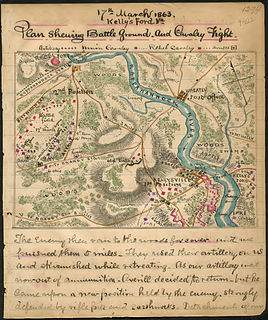
The Battle of Kelly's Ford, also known as the Battle of Kellysville or Kelleysville, took place on March 17, 1863, in Culpeper County, Virginia, as part of the cavalry operations along the Rappahannock River during the American Civil War. It set the stage for Brandy Station and other cavalry actions of the Gettysburg Campaign that summer. Twenty-one hundred troopers of Brig. Gen. William W. Averell's Union cavalry division crossed the Rappahannock to attack the Confederate cavalry that had been harassing them that winter. Brig. Gen. Fitzhugh Lee counterattacked with a brigade of about 800 men. After achieving a localized success, Union forces withdrew under pressure in late afternoon, without destroying Lee's cavalry.
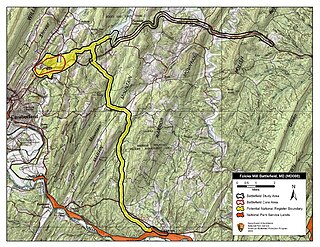
The Battle of Folck's Mill, also known as the Battle of Cumberland, was a small cavalry engagement, fought August 1, 1864, in northern Maryland, as part of the Valley Campaigns of 1864 during the American Civil War.

The Big Sandy Expedition was an early campaign of the American Civil War in Kentucky that began in mid-September 1861 when Union Brig. Gen. William "Bull" Nelson received orders to organize a new brigade at Maysville, Kentucky and conduct an expedition into the Big Sandy Valley region of Eastern Kentucky and stop the build-up of Confederate forces under Col. John S. Williams. This was done in three phases. From September 21 to October 20, 1861, Nelson assembled a brigade of 5,500 Union volunteers from Ohio and Kentucky. On October 23, the southern prong secured Hazel Green and the northern prong West Liberty. The two prongs were consolidated at Salyersville and they began the final phase on October 31. This led to the Battle of Ivy Mountain on November 8 and the withdrawal of Confederate forces from Pikeville (Piketon) on November 9, 1861.

The U.S. state of West Virginia was formed out of western Virginia and added to the Union as a direct result of the American Civil War, in which it became the only modern state to have declared its independence from the Confederacy. In the summer of 1861, Union troops, which included a number of newly-formed Western Virginia regiments, under General George McClellan, drove off Confederate troops under General Robert E. Lee. This essentially freed Unionists in the northwestern counties of Virginia to form a functioning government of their own as a result of the Wheeling Convention. Prior to the admission of West Virginia the government in Wheeling formally claimed jurisdiction over all of Virginia, although from its creation it was firmly committed to the formation of a separate state.

The Battle of Rowlett's Station was a land battle in the American Civil War, fought at the railroad whistle-stop of Rowlett's in Hart County, Kentucky, on December 17, 1861. The outcome was inconclusive, although the Union Army continued to hold its objective, a railroad bridge across the Green River.

The 7th Ohio Infantry Regiment was an infantry regiment formed in northeastern Ohio for service in the Union Army during the American Civil War. It served in the Eastern Theater in a number of campaigns and battles with the Army of Virginia and the Army of the Potomac, and was then transferred to the Western Theater, where it joined the Army of the Cumberland besieged at Chattanooga. It is of the 7th regiment that a war historian wrote, "All in all, considering the number of its battles, its marches, its losses, its conduct in action, it may be safely said that not a single regiment in the United States gained more lasting honor or deserved better of its country than the Seventh Ohio Volunteer Infantry."
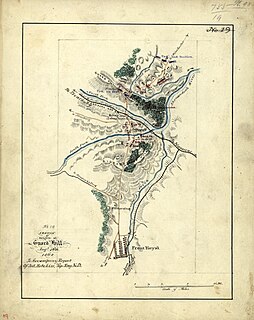
The Battle of Guard Hill,Battle of Crooked Run,Battle of Cedarville, or the Battle of Front Royal took place on August 16, 1864, in Warren County, Virginia as part of Philip H. Sheridan's Shenandoah Valley Campaign of the American Civil War. Confederate forces under Richard H. Anderson were sent from Petersburg to reinforce Early. Brig. Gen. Wesley Merritt's Union cavalry division surprised the Confederate columns while they were crossing the Shenandoah River, capturing about 300. The Confederates rallied and advanced, gradually pushing back Merritt's men to Cedarville. The battle was inconclusive.

The Battle of Marion was a military engagement fought between units of the Union Army and the Confederate Army during the American Civil War near the town of Marion, Virginia. The battle was part of Union Maj. Gen. George Stoneman's attack upon southwest Virginia, aimed at destroying Confederate industrial infrastructure near Saltville and Marion. Union Cavalry and Infantry regiments—some 4,500 soldiers in total—left Tennessee on December 17 for southwestern Virginia.

Erastus Bernard Tyler was an American businessman, merchant, and soldier. He was a general in the Union Army during the American Civil War and fought in many of the early battles in the Eastern Theater before being assigned command of the defenses of Baltimore, Maryland. He briefly commanded the VIII Corps.
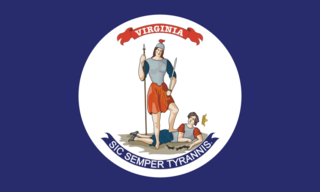
The 45th Virginia Infantry Regiment was an infantry regiment raised in the Commonwealth of Virginia for service in the Confederate States Army during the American Civil War. It fought mostly in the mountainous area that today encompasses the border regions of Virginia and West Virginia, and was part of Jubal Early's Army of the Valley during the Valley Campaigns of 1864.

The 36th Virginia Infantry Regiment was an infantry regiment mostly raised in the Kanawha Valley for service in the Confederate States Army during the American Civil War. It fought mostly in western Virginia, Tennessee, and Kentucky.

















